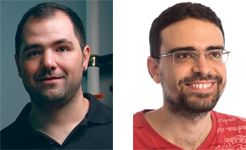Applications of Raman spectroscopy in the characterization of nanomaterials

Prof. Paulo T. Araujo, The University of Alabama, US
Prof. Alexandre R. Paschoal, Federal University of Ceara, Brazil
Raman spectroscopy is a non-invasive, non-destructive, and robust technique that provides a plethora of important information regarding materials properties, such as structural configuration, chemical composition, types of defects and respective densities, and doping mechanisms. Usually, phonons are the quasi-particles studied using this technique but other quasi-particles, such as plasmons or magnons, are also observed under specific conditions. When combined with variable temperature, pressure, magnetic and electric fields this technique facilitates the exploration of phase transitions and provides access to quantities such as heat capacity values, thermal expansion coefficients, Young's moduli, Grüneisen parameters, and magnetic and electric susceptibility values. In particular, a solid reputation has been built around Raman spectroscopy as a gold-standard technique to characterize nanostructured materials, contributing to the understanding of their properties and facilitating their application in new technologies including new medical treatments and more efficient materials for energy conversion, data storage, and transmission.
Contributions to this thematic issue are invited including, but not limited to, the following topics:
- Applications of enhanced Raman spectroscopy techniques (e.g., near-field and surface-enhanced Raman spectroscopy) in the characterization of nanomaterials
- Raman spectroscopy applied to transition metal dichalcogenides (TMDs) and transition metal oxides (TMOs)
- Raman spectroscopy applied to carbon materials, such as fullerenes, linear chains, nanotubes, and graphene and its multilayered forms
- Raman spectroscopy of two-dimensional hybrid materials
- Raman spectroscopy applied to soft-matter and molecular systems
- Characterization protocols using Raman spectroscopy to investigate defects in TMDs, TMOs, and carbon materials
Submission Deadline: November 30, 2023
*Please contact the guest editors directly if you still want to submit your article*
Determining by Raman spectroscopy the average thickness and N-layer-specific surface coverages of MoS2 thin films with domains much smaller than the laser spot size
- Felipe Wasem Klein,
- Jean-Roch Huntzinger,
- Vincent Astié,
- Damien Voiry,
- Romain Parret,
- Houssine Makhlouf,
- Sandrine Juillaguet,
- Jean-Manuel Decams,
- Sylvie Contreras,
- Périne Landois,
- Ahmed-Azmi Zahab,
- Jean-Louis Sauvajol and
- Matthieu Paillet
Beilstein J. Nanotechnol. 2024, 15, 279–296, doi:10.3762/bjnano.15.26

On the mechanism of piezoresistance in nanocrystalline graphite
- Sandeep Kumar,
- Simone Dehm and
- Ralph Krupke
Beilstein J. Nanotechnol. 2024, 15, 376–384, doi:10.3762/bjnano.15.34

Further insights into the thermodynamics of linear carbon chains for temperatures ranging from 13 to 300 K
- Alexandre Rocha Paschoal,
- Thiago Alves de Moura,
- Juan S. Rodríguez-Hernández,
- Carlos William de Araujo Paschoal,
- Yoong Ahm Kim,
- Morinobu Endo and
- Paulo T. Araujo
Beilstein J. Nanotechnol. 2025, 16, 1818–1825, doi:10.3762/bjnano.16.125























